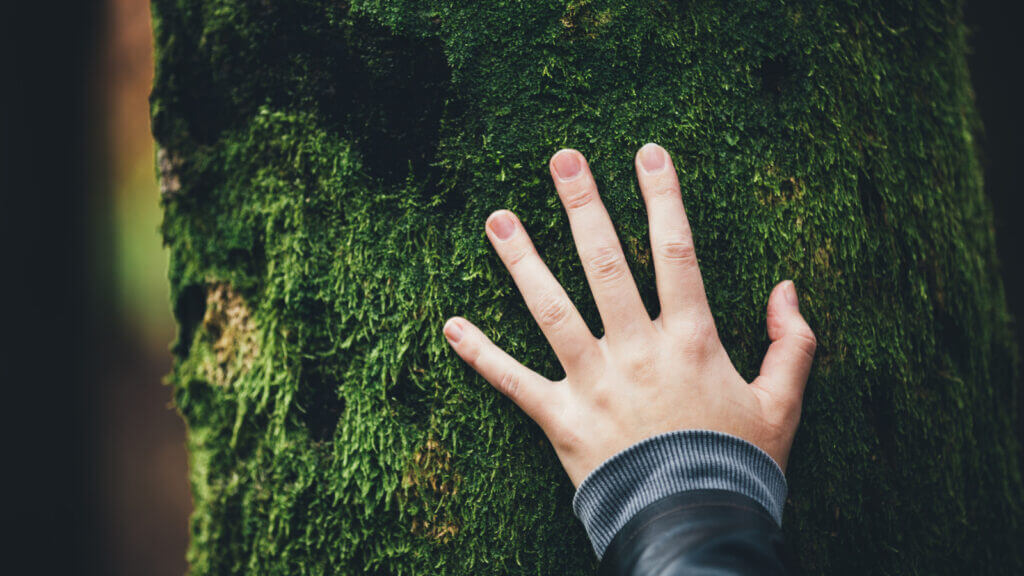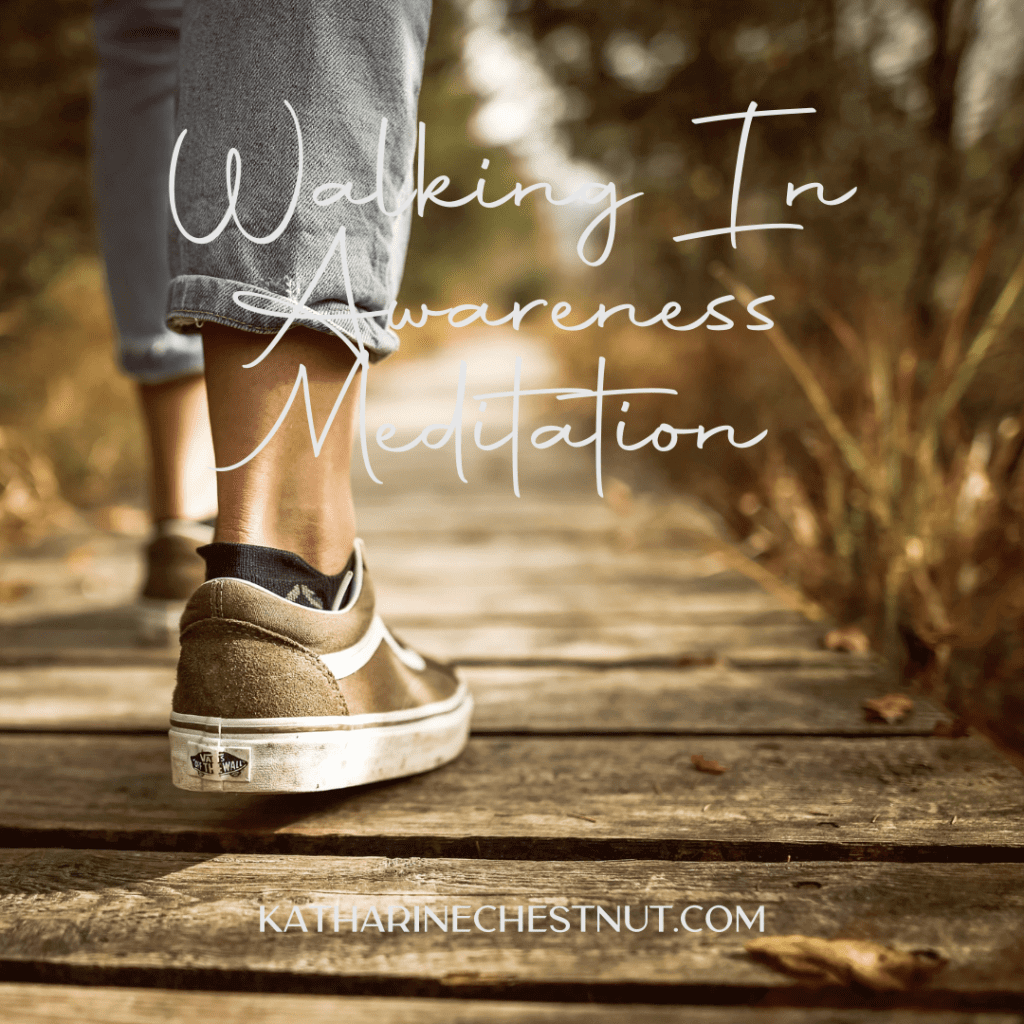
Mindfulness in Nature
Introducing our guest blogger, Ginny Rayne, from Naked Sustainability. With over a decade of experience in researching and implementing ways to be more planet-friendly, Ginny helps busy millennials make small decisions that add up to big, lasting changes for the planet, and all of us who call Earth home.
I’m thrilled to have her share her insights and wisdom with our readers. Without further ado, let’s dive into how Ginny has been able to create a mindfulness practice by connecting with nature.
How Connecting with the Outdoors Can Improve Your Mental Health

Being outside…surrounded by the sweet smell of flowers, the melodic song of the birds in the trees, the low hum of bees in the background, and that glorious sunshine…it has a way of calming my mind, almost immediately. At least that’s how I feel enjoying an afternoon on our back deck when I just can’t deal with work anymore.
When we’re surrounded by trees, sunshine, and fresh air, we automatically feel more connected to the world around us. We can see it, smell it, hear it, touch it, and sometimes (especially in my home state of Pennsylvania) taste the humidity in the air. This is why mindfulness in nature is such a powerful tool for improving our mental health; it grounds us with all five senses, and takes the world from an intangibility to a very tangible, but invisible hug.
Practicing mindfulness in nature involves being present in the moment and fully experiencing our surroundings. It’s about using our senses to connect with the natural world, whether that’s feeling the warmth of the sun on our skin, listening to the sound of birds singing, or smelling the scent of wildflowers. By focusing on these sensations, we can quiet our minds and reduce stress and anxiety and increase our feelings of connectedness.
Research has shown that spending time in nature can have a positive impact on our mental health, including reducing some of the mental health symptoms that are becoming more commonplace in today’s society. By combining mindfulness with nature, we can take this one step further and improve our overall well being. Whether we’re taking a walk in the park, hiking in the mountains, or simply sitting outside and enjoying the fresh air, mindfulness in nature can help us feel more grounded, relaxed, and at peace.
Understanding Mindfulness
As we explore the practice of nature-based mindfulness, it’s important to first understand what mindfulness is. Mindfulness is the practice of being present in the moment, without judgment or distraction. It’s about being aware of our thoughts, feelings, surroundings, and sensations without getting caught up in them. Mindfulness is often talked about as an outcome to meditation, but it can be practiced in many different ways. Mindfulness can be practiced through breathing methods, guided imagery, and other practices to relax the body and mind. With mindfulness training, we are working to cultivate a state of awareness and attention that can help us with stress reduction, and improve our overall health and well-being.
I’ve never been able to establish a traditional meditation practice; trust me, I’ve tried. I want it to work; I want to be the centered, nothing-bothers-me guru that my mind conjures up when I think about meditation and yogis…namaste, right??
I just can’t seem to quiet my mind from the incessant onslaught of thoughts from my current to-do list to a witty comeback for a conversation I had in sixth grade (yes, I’m still thinking of these conversations two decades later). But mindful awareness is different. It lets me focus my thoughts in the present. They can still be all over the place, but when I’m experiencing the beauty of nature, my brain has the bees hopping from flower to flower and the gentle rustle of the breeze to help guide my thoughts away from the stress, overwhelm, and negativity of my day.
One of the key aspects of mindfulness is learning to focus our attention on what is right in front of us. This means that we let go of worries about the past (like my sixth grade witty comebacks) or future, and instead focus on what is happening right now. When we do this, especially within nature, we often find that we are better able to appreciate the beauty and wonder of the natural settings around us. Being in nature helps bring me, and keep me, focused on the here-and-now.
Mindfulness and the Connection with Nature

I have found that being in nature has been one of the most effective ways to deepen my practice and cultivate a sense of peace and calm. I, unknowingly, have practiced mindfulness in nature for several years, simply due to the fact that exposure to nature made me feel good and I didn’t know why.
Nature can be a powerful tool for enhancing (or helping to create) a mindfulness practice and I’ve only just connected these dots myself within the last year.
The Essence of Nature in Mindfulness
Nature has a way of bringing us back to the present moment and helping us connect with our senses. When we are in nature, we are surrounded by sights, sounds, and smells that can help us become more aware of our surroundings and our own internal states. This heightened awareness can help us develop a greater sense of mindfulness and presence and is sometimes referred to as forest bathing.
Additionally, nature has a way of reminding us of our interconnectedness with all living things. When we take time to enjoy nature, we begin to see ourselves as part of a larger ecosystem and realize that our actions have an impact on the world around us. This realization can help us develop a greater sense of compassion and empathy for others.
Nature as a Mindful Space
Whether we are walking through a forest, sitting by a river, or watching the sunset, mother nature provides a peaceful and calming environment, increasing our relaxation and bringing our attention back to the present moment.
One of the most effective ways to practice mindfulness is taking a walk in nature. This involves walking slowly and deliberately, paying attention to the sensations in our feet and legs, and observing our surroundings with curiosity and openness. Other ways to be more reflective and aware in nature can be through guided meditations focused on your natural surroundings, journaling on your connection to nature, or even eating mindfully.
By connecting with nature, we can deepen our sense of presence, compassion, and interconnectedness with the world around us.
Mindfulness Activities in Nature
When it comes to practicing mindfulness, nature provides the perfect environment to connect with the present moment and find our inner peace. Personally, I don’t have a dedicated practice in the way you might think. I spend time outdoors everyday, especially during gardening season. I incorporate Mother Nature into all of our family activities, from walking, dining out, and even just decompressing from our work days. It’s become natural for me to hike through the forests, softly brushing the leaves of the trees and admire the strength and beauty around me.
My point here is that this practice doesn’t have to be difficult. You don’t have to create a quiet space, grab a zafu, download a thoughtful meditation, and ensure you have no distractions–I don’t think I could ever make that work in my life. But you can walk outside and feel the soft grass beneath your feet (or sunshine hitting your skin), for just a couple minutes, no planning required.
If you are looking for ways to get started in creating a practice involving your natural surroundings, here are three ways you can use to get a use nature to fuel your5 personal growth:

Mindful Walking
One way to practice mindfulness in nature is by taking a walk. This practice involves walking slowly and intentionally, paying attention to each step and the sensations in your body. As you walk, focus on your breath and the sights, sounds, and smells around you. You can practice mindful walking in any natural environment, whether it’s a park, forest, or beach.
Mindful Observation
Another way to practice mindfulness in nature is through observation. Find a spot to sit or stand and simply observe your surroundings. Pay attention to the details of the natural world around you, from the patterns in the leaves to the movements of the animals. As you observe, try to let go of any judgments or thoughts and simply be present with what you see.
Mindful Listening
Finally, you can engage in mindfulness by listening. Find a quiet spot and close your eyes. Listen to the sounds around you, from the rustling of the leaves to the chirping of the birds. Try to focus on each sound individually, without labeling or judging them. Simply be present with the sounds and let them wash over you.
By practicing mindfulness in nature, we can cultivate a deeper connection with ourselves and the world around us. Whether it’s through walking, observation, or listening, taking the time to be present in nature can help us find peace and clarity in our lives.
Benefits of a Mindfulness Practice in Nature
As someone who has practiced mindfulness in nature for years, I can attest to the positive effects it provides for both physical and mental health. Here are some of the benefits I have experienced and that are supported by research:
Physical Health Benefits
- Reduces stress: Spending time in natural surroundings and practicing mindfulness has been shown to reduce levels of the stress hormone cortisol, which can have a positive impact on overall physical health.
- Boosts immune system: Studies have found that being surrounded by nature and practicing mindfulness can boost the immune system, leading to a stronger defense against illness and disease.
- Increases physical activity: Being in nature often leads to increased physical activity, whether it’s walking, hiking, or simply moving around more. This increased activity can have numerous physical health benefits, such as improved cardiovascular health, lower blood pressure, and weight management.
Mental Health Benefits
- Reduces anxiety and depression: Mindfulness in nature has been found to reduce symptoms of anxiety and depression, leading to improved mental and physical health.
- Improves cognitive function: Spending time in nature and practicing mindfulness has been shown to improve cognitive function, including attention, memory, and creativity.
- Increases feelings of happiness and wellbeing: Being in nature and practicing mindfulness has been linked to increased feelings of happiness and overall wellbeing.
Final Thoughts on Mindfulness in Nature
By intentionally (or unintentionally in my case) integrating mindfulness and nature into our daily lives, we can reduce anxiety, improve our physical health, and increase our connection with the natural world.
Increasing our connection with the natural world fosters a deep appreciation for our planet. For me, this appreciation guided me to my passion of protecting the planet. And this passion has helped me implement more sustainable practices in my life, such as reducing my waste, conserving resources like rainwater, and using renewable energy like solar, instead of fossil fuels.
Our future on this planet will be decided by two things: all of us coming together and building a thriving and innovative future, AND having healthy natural ecosystems to maintain the world as we know it; a strong connection with nature crafted through mindfulness can help to achieve this balance.
I, Ginny, challenge you to take some time today to connect with nature and open your mind. And then, maybe do it again tomorrow, and the next day…Whether it’s a walk in the park, a hike in the woods, or simply sitting outside and observing the world around us, we can all benefit from the healing power of nature and the practice of mindfulness.
I was honored to have Ginny ask me to contribute to her blog and couldn’t wait to return the opportunity. Her perspective on the importance of being in nature to encourage mindfulness was so validating. Along with acknowledging the benefits and healing that we all receive when we truly feel interconnectedness of us all.
Now I think I head out for a walk because doing that 3-4x daily is my way of staying connected to nature.




